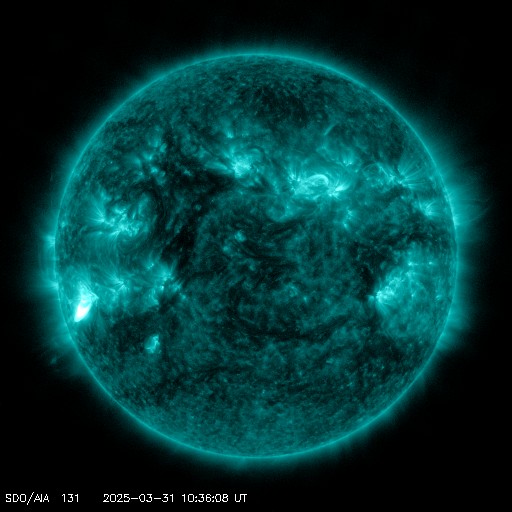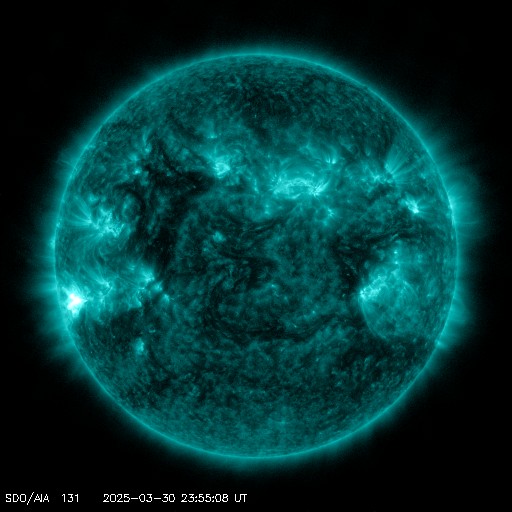Viewing archive of Monday, 29 March 1999
Solar activity report
Any mentioned solar flare in this report has a scaling factor applied by the Space Weather Prediction Center (SWPC). Because of the SWPC scaling factor, solar flares are reported as 42% smaller than for the science quality data. The scaling factor has been removed from our archived solar flare data to reflect the true physical units.
Report of Solar-Geophysical Activity 1999 Mar 29 2200 UTCPrepared by the NOAA © SWPC and processed by SpaceWeatherLive.com
Joint USAF/NOAA Report of Solar and Geophysical Activity
SDF Number 088 Issued at 2200Z on 29 MAR 1999IA. Analysis of Solar Active Regions and Activity from 28-2100Z to 29-2100Z
SOLAR ACTIVITY WAS VERY LOW. REGION 8502 (S23W17) WAS
THE MOST ACTIVE REGION PRODUCING AN ISOLATED B3/SF AT 29/1705UT. A
NEW SPOT APPEARED ON THE LIMB JUST WEST OF REGION 8502. DUE TO THE
PROXIMITY OF THE LIMB THE OBSERVATORIES ARE UNABLE TO DETERMINE IF
THERE ARE TWO BACK-TO-BACK REGIONS OR A SINGLE LARGE SPOT GROUP AT
THIS TIME. ONE NEW SPOT GROUP WAS NUMBERED, REGION 8503 (S23W15).
IB. Solar Activity Forecast
SOLAR ACTIVITY IS EXPECTED TO BE VERY
LOW.
IIA. Geophysical Activity Summary 28-2100Z to 29-2100Z
THE GEOMAGNETIC FIELD WAS QUIET TO ACTIVE WITH A MINOR STORM PERIOD
OCCURRING AT 29/1500-1800UT. THIS WAS PROBABLY DUE TO A CORONAL HOLE
HIGH SPEED STREAM.
IIB. Geophysical Activity Forecast
THE GEOMAGNETIC FIELD IS
EXPECTED TO BE QUIET TO UNSETTLED. A HIGH SPEED STREAM COULD
CONTINUE TO ELEVATE ACTIVITY MARCH 30-31.
III. Event Probabilities 30 MAR to 01 APR
| Class M | 01% | 01% | 01% |
| Class X | 01% | 01% | 01% |
| Proton | 01% | 01% | 01% |
| PCAF | GREEN | ||
IV. Penticton 10.7 cm Flux
Observed 29 MAR 104 Predicted 30 MAR-01 APR 110/110/115 90 Day Mean 29 MAR 138
V. Geomagnetic A Indices
OBSERVED AFR/AP 28 MAR 007/006 ESTIMATED AFR/AP 29 MAR 015/018 PREDICTED AFR/AP 30 MAR-01 APR 015/015-015/010-010/010
VI. Geomagnetic Activity Probabilities 30 MAR to 01 APR
| A. Middle Latitudes | |||
|---|---|---|---|
| Active | 25% | 25% | 15% |
| Minor storm | 10% | 10% | 05% |
| Major-severe storm | 01% | 01% | 01% |
| B. High Latitudes | |||
|---|---|---|---|
| Active | 25% | 25% | 15% |
| Minor storm | 10% | 10% | 05% |
| Major-severe storm | 05% | 05% | 01% |
All times in UTC
Current data suggests there is a slight possibility for aurora to appear at the following high latitude regions in the near future
Whitehorse, YTAnchorage, AK, Fairbanks, AK, Juneau, AK, Utqiagvik, AK
Latest news
Latest forum messages
Unspecified geomagnetic activity 2147AR4048 38AR4046 136Solar Demon 3Aurora photography hints for those of us with smartphones 54
More topicsSupport SpaceWeatherLive.com!
A lot of people come to SpaceWeatherLive to follow the Sun's activity or if there is aurora to be seen, but with more traffic comes higher server costs. Consider a donation if you enjoy SpaceWeatherLive so we can keep the website online!

Latest alerts
11:15 UTC - Solar protons
Minor S1 Solar Radiation Storm - Minor impacts on HF radio through polar regions
10:45 UTC - Solar flare
Moderate M1.26 flare
10:27 UTC - Radio Blackout
Minor R1 radio blackout in progress (≥M1 - current: M1.22)
00:09 UTC - Solar flare
Moderate M1.03 flare
Sunday, 30 March 2025
23:51 UTC - Radio Blackout
Minor R1 radio blackout in progress (≥M1 - current: M1.03)
Space weather facts
| Last X-flare | 2025/03/28 | X1.1 |
| Last M-flare | 2025/03/30 | M1.0 |
| Last geomagnetic storm | 2025/03/27 | Kp5 (G1) |
| Spotless days | |
|---|---|
| Last spotless day | 2022/06/08 |
| Monthly mean Sunspot Number | |
|---|---|
| February 2025 | 154.6 +17.6 |
| March 2025 | 127 -27.6 |
| Last 30 days | 127 -25.7 |




